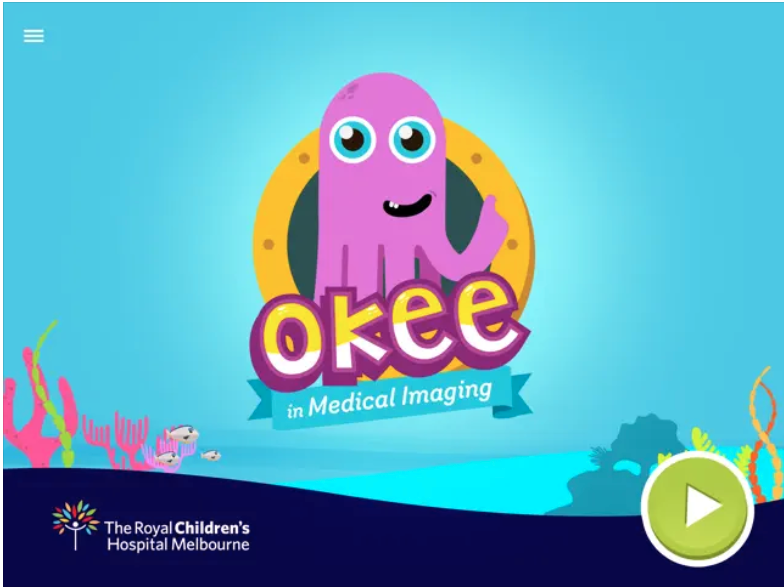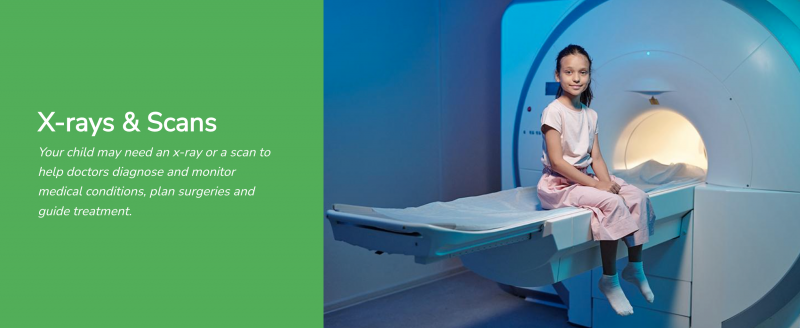MRI Scans For Children
MRI Scans For Children
MRI scans help doctors diagnose and monitor medical conditions, plan surgeries, and guide treatments. Find out more about what MRI involves.
Key points about MRI in children
- MRI stands for magnetic resonance imaging
- an MRI scanner can take detailed pictures of the body
- there is no radioactivity present during an MRI scan
- MRI scans help doctors diagnose and monitor medical conditions, plan surgeries, and guide treatments.
What is MRI?
MRI is a special type of scan that can take detailed pictures of different parts of the body, such as the brain or bones. A doctor may recommend MRI to help understand what's happening inside your child's body.
How long will my child's MRI take?
Having an MRI scan usually takes about 30 to 60 minutes. But it can take anywhere from 15 to 90 minutes - depending on what type of pictures your child needs.
How does MRI work?
MRI takes pictures using radio waves and a magnet. Sometimes, your child might feel a bit warm when they are having their scan, but other than that, they will not feel anything. They will be able to talk with the technician taking the scan the whole time.
Who will my child meet during their MRI?
The person who takes your children's pictures is the MRI technician. They can answer your questions and let your child know what they need to do.
You may also meet other people, such as a nurse or play therapist. A radiologist is the doctor who will look at your children's pictures after the MRI scan.
What will my child see during their MRI?
MRI machine
The MRI camera is a big machine that looks a bit like a tunnel. It is large enough to take photos of the whole body. The photo of the MRI scanner below is from The Royal Children's Hospital, Melbourne.
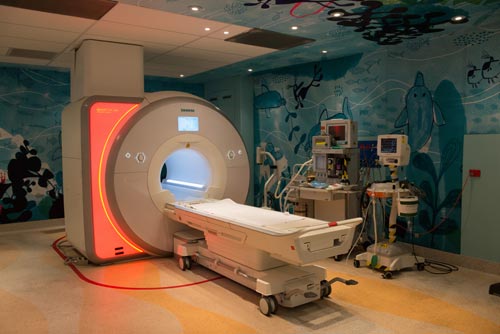
The MRI technician may use some extra things - it depends what body part your child is having scanned. These extra things help to make sure they get the best quality pictures from the scan.
Headphones
The MRI machine can be noisy when it takes the picture. Your child will get headphones to help block out some of the camera sounds. Your child may listen to music or a movie while having their scan.
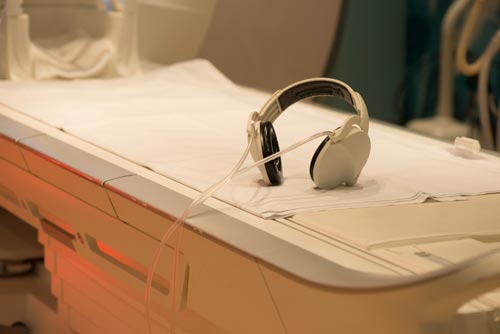
Coils
Coils help make sure the MRI pictures turn out well. There are different coils for different body parts. Coils go over or around the body part your child is having scanned.
The head coil is like a special helmet with a mirror that helps your child watch a movie while they are in the MRI tunnel. It clicks in beside your child's head but won't move or touch them. Depending on what body part is scanned, your child may enter the MRI machine head first or feet first.
Some examples of the different types of coils that could be used for an MRI
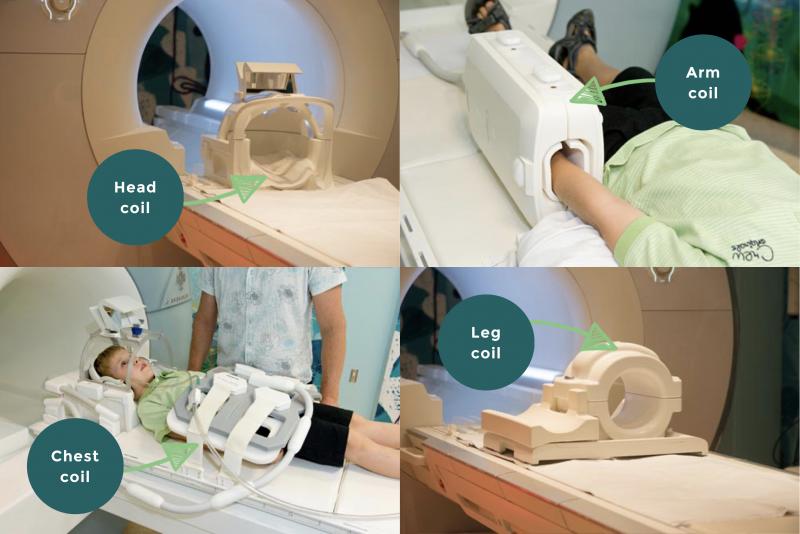
Will my child need any preparation before their MRI?
Depending on your child's age, they may need sedation or a general anesthetic before their MRI scan. Some tamariki may also need to be given contrast or a tracer to help get better pictures during their scan.
Contrasts and tracers
Sometimes, MRI scan pictures need something called 'contrast'. If your child needs contrast, this will usually be written in your appointment letter. Occasionally, that decision is made at the time of the scan. If your child needs contrast, they may need to arrive earlier for their appointment. This gives the staff time to prepare and give the contrast before the scan.
Contrasts and tracers are special liquids that go into the body and change the way the pictures look. There are lots of different types of contrast - some you drink and others that need to go into a vein with a little straw called a 'cannula' or 'drip'.
See the KidsHealth page to learn more about drips
General anaesthetic (GA)
Some tamariki may find it hard to stay still long enough to have their scan. Some tamariki may need a general anaesthetic to help them go into a short sleep while they have their scan. Your appointment time will be longer if your child needs a GA.
See the KidsHealth page on anaesthetic to learn more about what a GA involves
Sedation
Sedation may be preferred to a general anaesthetic for younger tamariki up to 12 months old. The doctor will discuss this with you before the scan. If your child needs sedation, your appointment will take longer.
What will my child need to do during their MRI?
Keeping still
It is important that your child tries to keep still while they have their scan. If they move around too much, it can make the pictures blurry. It is OK for your child to breathe normally, blink and stay relaxed.
Holding their breath
If your child is having images taken of their chest or abdomen (tummy area), they may be asked to hold their breath for short periods. You can practise this before their appointment.
What to wear
Have your child dressed in comfy clothes. The MRI camera has magnets, so it's really important your child has no metal in their clothes or on their body. If you forget, your child can wear a hospital gown.
Metal things to avoid wearing include:
- zippers
- metal buttons
- press studs
- jewellery
- metal hair ties and hair clips
- clothes with glitter or sequins
As a parent or whānau member, you will also need to avoid wearing metal items if you want to stay in the MRI room while the scan is happening.
How can I help prepare my child for their MRI?
Asking questions
Check the date and time of your child's scan and see if there is anything you need to do beforehand to prepare. If you have any questions about the scan, contact the hospital where the scan will take place. Ask to speak to the reception at the MRI department.
Play therapy
Some hospitals have play therapists that could be involved with your child and their scan. They can support your child with activities to help them feel more comfortable about getting a scan.
What to bring
Sometimes, you may need to wait around before your child has their scan. It's a good idea to bring some things to keep your child busy, such as books or toys. Your child may be able to take a favourite soft toy or comforter into the scan with them.
Preparing your child
It is important to talk to your child and explain why they are having a scan and what it will involve. How and when you do this will depend on their age and your judgement. The Okee in Medical Imaging App can help you to prepare your child for their scan.
Okee in Medical Imaging App
The Royal Children's Hospital Melbourne has an app you can download onto your phone or tablet. It has games that help your child to practise keeping still and holding their breath. It also has games that help explain the different types of scans.
The app is called Okee in Medical Imaging and is available from the app store.
Please be aware that some of the content in the app is specific to Royal Children's Hospital Melbourne.
See more KidsHealth content on x-rays and scans
See the KidsHealth page on MRI of the brain
This page last reviewed 13 September 2023.
Do you have any feedback for KidsHealth?
If you have any feedback about the KidsHealth website, or have a suggestion for new content, please get in touch with us.
Email us now